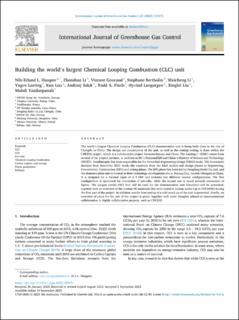Building the world's largest Chemical Looping Combustion (CLC) unit
| dc.contributor.author | Haugen, Nils Erland L | |
| dc.contributor.author | Li, Zhenshan | |
| dc.contributor.author | Gouraud, Vincent | |
| dc.contributor.author | Bertholin, Stephane | |
| dc.contributor.author | Li, Weicheng | |
| dc.contributor.author | Larring, Yngve | |
| dc.contributor.author | Luo, Kun | |
| dc.contributor.author | Szlek, Andrzej | |
| dc.contributor.author | Flach, Todd | |
| dc.contributor.author | Langørgen, Øyvind | |
| dc.contributor.author | Liu, Xinglei | |
| dc.contributor.author | Yazdanpanah, Mahdi | |
| dc.date.accessioned | 2023-11-20T11:51:10Z | |
| dc.date.available | 2023-11-20T11:51:10Z | |
| dc.date.created | 2023-09-26T09:33:46Z | |
| dc.date.issued | 2023 | |
| dc.identifier.issn | 1750-5836 | |
| dc.identifier.uri | https://hdl.handle.net/11250/3103552 | |
| dc.description.abstract | The world's largest Chemical Looping Combustion (CLC) demonstration unit is being built close to the city of Chengdu in China. The design and construction of the unit, as well as the coming testing, is done within the CHEERS project, which is a collaborative project between Europe and China. The funding (∼25M€) comes from several of the project partners, in addition to EU's Horizon2020 and China's Ministry of Science and Technology (MOST). TotalEnergies has been responsible for the Front-End Engineering Design (FEED) study. The investment decision from December 2021 marks the transition from the R&D studies and design phases to Engineering, Procurement, Construction (EPC) and testing phase. The EPC phase has been led by Dongfang Boiler Co.,Ltd, and the demonstration unit is located at their technology development site in Deyang City, outside Chengdu in China. It is designed for a thermal input of 2–4 MW and includes two different reactor configurations. The first configuration is optimized for conversion of pet-coke, while the second one is tuned towards conversion of lignite. The oxygen carrier (OC) that will be used for the demonstration unit (ilmenite) will be presented, together with an overview of the various OC materials that were tested at various scales (up to 150 kWth) during the first part of the project. In addition, results from testing of a cold mock-up of the unit is presented. Finally, an overview of plans for the rest of the project is given, together with some thoughts related to intercontinental collaboration in highly collaborative projects, such as CHEERS. © 2023 The Author(s) Author keywords Carbon capture and storage; CCS; Chemical Looping Combustion; CLC; Pet-coke; Power production; Refinery | en_US |
| dc.description.abstract | Building the world's largest Chemical Looping Combustion (CLC) unit | en_US |
| dc.language.iso | eng | en_US |
| dc.publisher | Elsevier | en_US |
| dc.rights | Navngivelse 4.0 Internasjonal | * |
| dc.rights.uri | http://creativecommons.org/licenses/by/4.0/deed.no | * |
| dc.title | Building the world's largest Chemical Looping Combustion (CLC) unit | en_US |
| dc.title.alternative | Building the world's largest Chemical Looping Combustion (CLC) unit | en_US |
| dc.type | Peer reviewed | en_US |
| dc.type | Journal article | en_US |
| dc.description.version | publishedVersion | en_US |
| dc.rights.holder | The Authors | en_US |
| dc.source.volume | 129 | en_US |
| dc.source.journal | International Journal of Greenhouse Gas Control | en_US |
| dc.identifier.doi | 10.1016/j.ijggc.2023.103975 | |
| dc.identifier.cristin | 2178814 | |
| dc.relation.project | EC/H2020/764697 | en_US |
| dc.source.articlenumber | 103975 | en_US |
| cristin.ispublished | true | |
| cristin.fulltext | original | |
| cristin.qualitycode | 1 |
Tilhørende fil(er)
Denne innførselen finnes i følgende samling(er)
-
Publikasjoner fra CRIStin - SINTEF Energi [1614]
-
SINTEF Energi [1731]
-
SINTEF Industri [1542]

